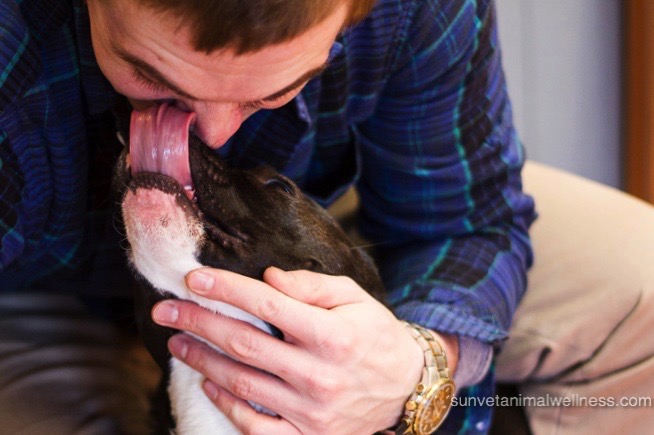Animal Separation Anxiety
Many social animals—dogs, cats, birds, horses, whales, monkeys—experience separation anxiety because they have evolved to live within a social structure strengthened by emotional bonds. A dog or cat dealing with this will feel severe nervousness when you’re away, usually manifesting within thirty minutes of you leaving. An animal with genuine separation anxiety is experiencing the equivalent of a human panic attack! These are brief spells of intense visceral fear, the kind of fear that could keep them alive in the face of danger. Your sweet companion will have no control over their response. It is important to bear all of this in mind when thinking about how to deal with the symptoms of this extreme stress
Early Warning Signs that Anxiety may be a Problem:
Dogs and cats who at first seem exceptionally eager to see their humans are often brewing a full-blown case of separation anxiety. Behaviors to watch for in your four-legged friend include:
- He needs to be within a few feet of you at all times
- She gives you a frenzied greeting every time you come home, whether you’ve been gone five days or five minutes
- His mood changes noticeably as you go about preparing to leave the house. Cats may sulk and hide or try to get between you and the door
- She engages in behaviors while you’re gone that she doesn’t do when you’re home
If you’re confused about whether your dog or cat is suffering separation anxiety or simple boredom, keep in mind that the behaviors that result from separation anxiety occur only when you’re not around and every time you’re not around.
Separation Anxiety Behaviors:
These anxiety behaviors could be termed “inappropriate coping behaviors” because our feline and canine companions don’t mean to do it, but can’t help themselves.
- Vocalizing. This is typically barking, whining, meowing or howling that starts before you leave or soon after, and continues for most of the time you are away. Chances are your neighbors will soon let you know if this is a problem!
- Drooling. Excessive salivation is considered by experts to be a red flag for separation anxiety when it only occurs when a dog is alone or believes she’s alone.
- Accidents in the house. Your canine or feline has pee and/or poop accidents in random locations around your house rather than in one consistent spot (or litter box), and this only happens when he’s alone or believes he’s alone.
- Destructive behavior. Dogs with separation anxiety typically cause damage to doors or windows (exit points), or personal items such as clothing, pillows, or the TV remote control. Confining these dogs to a kennel or carrier often causes an escalation of the behavior and can result in self-injury.
- Inappetance/vomiting. He may become too anxious to eat or will vomit only when you are not there.
- Pacing. Any one of these behaviors may be accompanied by pacing.
- Breaking out. In severe cases, the dog may have a panic attack and hurt herself by breaking through windows or attempting to get out of her crate.
- Over grooming. Cats may compulsively and repetitively groom themselves. This is called barbering or psychogenic grooming. This can create bald patches in areas that are easy to reach such as flanks, belly or hind limbs.
Causes of Separation Anxiety
Obviously, there are both genetic and environmental factors to consider when trying to figure out the causes of your four-legged companion’s anxiety. Put yourself in his fuzzy coat and you may be able to come up with the cause, such as:
- A change in the amount of time you are absent
- A move to a different house (with the same family)
- A new home (a move for Fido to a new family)
- The death of a family member (human or furry pal)
- A new baby
- Time spent in a boarding kennel or away from you
- Time spent at the veterinary clinic
- Being orphaned or weaned early
As you are sleuthing out all possibilities for any of these destructive behaviors, keep in mind, that if you have a baby animal, new dog or cat, or geriatric feline/canine, there could be other reasons for the above behaviors, like:
- A need for house-training
- A marking habit
- Submissive or excitement urination
- Teething
- Boredom chewing or digging
- Cognitive dysfunction
- A phobia about thunderstorms or other sounds
- Inappropriate urination or defecation can also be a sign of a medical problem such as seizures, diabetes, Cushing’s disease, renal disease, cystitis, or gastrointestinal distress
Separation Anxiety Solutions
One thing is for sure. If your sweet, but seemingly crazy companion has separation anxiety, it will not just disappear. Without intervention, her anxiety, and therefore frenzy, will most likely escalate over time. Your frustration is likely to peak also. However, all is not lost! Fortunately, you can prevent or cure your buddy’s separation anxiety. You must remember, helping your friend to overcome separation anxiety will take patience and time. Let’s take a look at some strategies to help break the stress cycle:
Never yell or use physical punishment if you arrive home to destruction or a mess on the floor. It’s very important to remember that these are not signs of misbehavior, but clinical anxiety and your four-legged companion isn’t in control when he’s doing them. Punishing him, especially after the fact, will only increase his anxiety level.
- Plenty of exercise. When in doubt, wear them out! This will help her relax.
- Offer treat-release toys such as a Kong before leaving. There are mental stimulation, treat-release games for cats, too. Only give treats as you leave and not as you return.
- Place treats around the house so he can discover them.
- Leave out an article of clothing with your scent on it.
- After you bring your dog or pup home for the first time, acclimate her to periods of time away from you by practicing departures and brief absences.
- Challenge your friend mentally by working on obedience training and problem-solving.
- Invest in an Adaptil spray, collar, or diffuser for your dog or a Feliway spray or diffuser for your cat (available in our Asheville Clinic). Adaptil and Feliway are pheromones designed to have a calming effect on dogs and cats respectively. The collar seems to work well for many dog owners with pups suffering from separation anxiety and other stress-related behaviors. This can also work well in conjunction with training.
- Place flower essences or homeopathics in his water to energetically encourage a feeling of peace and calm. Sunvet Animal Wellness Clinic carries King Bio Anxiety Relief and Rescue Remedy Glycerin Formula. The use of Clinical Kinesiology allows us to customize which supplement would create the most appropriate response.
- Put on some soothing music before you leave. Some cats and dogs enjoy television with nature programs. A couple of videos that your four-legged buddies might enjoy can be found here and here.
- Use a verbal cue as you leave such as “I’ll be back” or “Thanks for watching the house”
- Keep your departures and arrivals as quiet and low key as you can. For 30 minutes before you leave, ignore your dog/cat. Be chilled out. Expect your buddy’s attention seeking behaviors to possibly escalate for a time before they start to decrease.
- When you arrive home, ignore your friend until she’s relaxed. Don’t interact with or acknowledge her until she’s no longer in a welcome-home frenzy.
- Making the cat’s environment more stimulating may help. A comfortable perch that allows a view from a window can provide entertainment, especially if there is a bird feeder in sight. Climbing ledges or carpeted towers with attached toys can be fun also.
- Work on desensitization to departure cues (See below)
Desensitization to Departure Cues
- Make a list of activities you perform before leaving home that signal to your dog that your departure is imminent and result in her becoming more and more anxious as the time draws near (collecting your keys, coat, purse, etc.). Perform this activity sequence at times when you aren’t leaving the house to disassociate the activities with your impending departure. You may need to do this 10 times per day for weeks or months to quell your dog’s anxiety.
- At home while going about your day or evening, train your dog to assume a calm, relaxed demeanor during “separations” when you’re in one room and he’s in another. First, move a short distance from your dog (while you’re in the same room) and then return and reward him with a treat.
- Repeat this step at the same distance until you’re sure your dog is very relaxed, then gradually increase the distance until you’re almost out of the room, making sure to give praise and treats when your dog stays relaxed and in place.
- Another strategy is to walk into closets and close the door behind you. Wait one minute and then reappear. You can also exit via an outside door that you normally don’t leave through. Wait one minute and then walk back in. If your dog doesn’t appear anxious, try two minutes and add time if the dog continues to be comfortable with it. If the dog becomes stressed, back off on your time.
- Once you’ve increased the distance until you’re out of your dog’s sight, you can begin to gradually increase the time he’s in one room and you’re in another. If the minute you’re out of sight your dog comes running, he needs more time to work up to that level of separation.
This process can take eight weeks or longer. If you don’t feel like your dog is making good progress or that you need further guidance, talk with your veterinarian, a positive dog trainer or a specialist in canine behavior. At Sunvet Animal Wellness, we keep a list of our favorite dog trainers to share, feel free to give us a call.
Certainly, life goes on during this training time and you can’t always be home. The reality is that your stressed canine may be destructive, or may hurt herself while you are waiting for the training to have an effect. You may need to make some arrangements for her in the meantime.
A few suggestions:
- Take your dog with you, if possible
- Leave him with a caretaker — maybe a friend who works from home or a retired neighbor or relative
- Hire a dog sitter to stay in your home with your dog
- Take him to a doggy daycare
- Discuss homeopathic, nutraceutical, and herbal relaxants with your holistic veterinarian
Sunvet Animal Wellness Clinic offers in-clinic and at-a-distance Pranic Healing Psychotherapy for dogs and cats. This modality has offered much relief to stressed beings and works exceptionally well in conjunction with positive training.
The most important thing is to hang in there! Over time, with patience and determination, you and your four-legged love muffins can get your paws on the peace you deserve.
Do you have a story about Dr. Laurel’s dog advice or how she helped your dog or cat? Please post your comment on our Facebook page or write a Google Review


